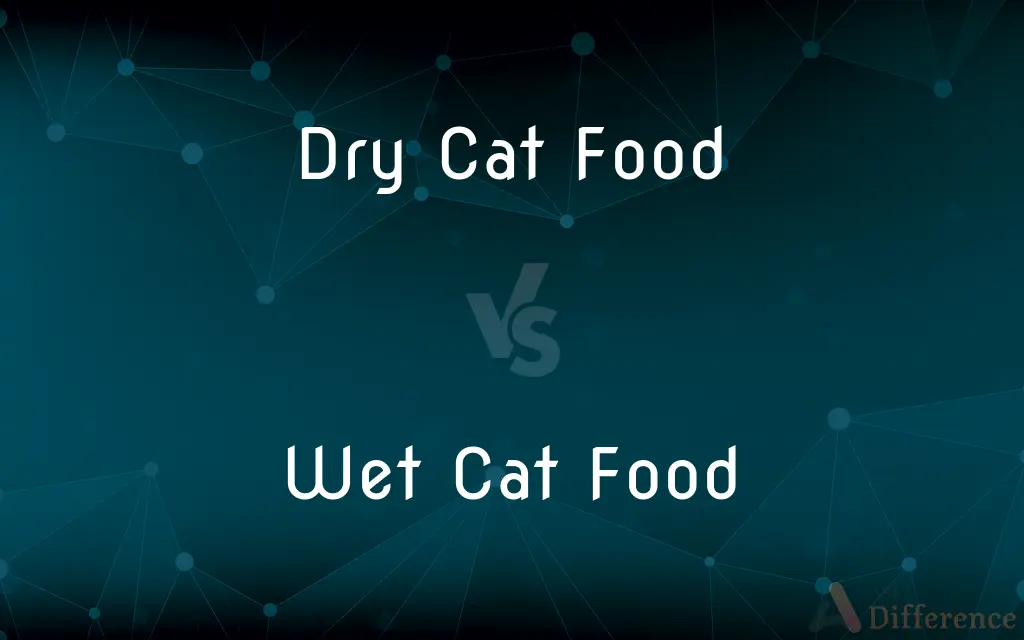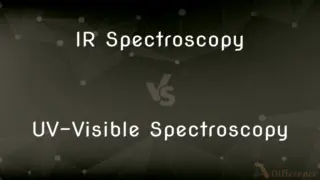Dry Cat Food vs. Wet Cat Food — What's the Difference?
By Tayyaba Rehman & Maham Liaqat — Published on February 22, 2024
Dry cat food, convenient and cost-effective, supports dental health with its crunchy texture, while wet cat food offers higher moisture content, beneficial for hydration, and tends to be more palatable for finicky eaters.

Difference Between Dry Cat Food and Wet Cat Food
Table of Contents
ADVERTISEMENT
Key Differences
Dry cat food, characterized by its low moisture content (typically around 10%), offers the convenience of long shelf life and ease of storage. It's often recommended for its role in promoting dental health through the mechanical action of chewing, which can help reduce tartar buildup. On the other hand, wet cat food, with a moisture content usually above 75%, is closer to the natural hydration levels of a cat's prey, making it particularly beneficial for cats with urinary tract issues or those prone to dehydration.
The cost-effectiveness of dry food is a significant advantage for many pet owners, as it typically comes at a lower price point per serving compared to wet food. However, wet cat food's higher protein content and lower carbohydrate levels can more closely align with a cat's natural carnivorous diet, offering nutritional benefits that might outweigh the cost difference for some owners.
Wet cat food's texture and variety, ranging from pate to chunks in gravy, can be more appealing to picky eaters, potentially leading to better food intake for cats that are less enthusiastic about dry kibble. Despite the benefits of wet food, some owners prefer the simplicity of dry food, which can be left out for "free feeding" without the risk of spoiling quickly.
Both types of cat food have their place in a balanced feline diet, and many veterinarians recommend a combination to take advantage of the benefits of both. This mixed feeding approach can help cater to a cat's nutritional needs, encourage hydration, and satisfy their appetite for variety.
The choice between dry and wet cat food will depend on a cat's health, dietary needs, and personal preferences, as well as the owner's lifestyle and budget. Regular consultations with a veterinarian can help determine the most appropriate diet for an individual cat, considering factors like age, activity level, and any existing health conditions.
ADVERTISEMENT
Comparison Chart
Moisture Content
Low (~10%)
High (>75%)
Cost
Generally more cost-effective
Typically more expensive per serving
Dental Benefits
Promotes dental health via chewing
Less impact on dental health
Palatability
May be less appealing to picky eaters
Often more appealing to cats
Storage & Convenience
Easy to store, longer shelf life
Requires refrigeration after opening
Nutritional Content
Higher in carbohydrates
Higher in protein, lower in carbs
Hydration
Lower moisture content
Helps increase overall hydration
Recommended For
Healthy adult cats, free feeding
Cats needing more hydration, seniors
Shelf Life
Longer
Shorter, must be used quickly after opening
Variety
Limited textures
Wide range of textures and flavors
Compare with Definitions
Dry Cat Food
A convenient and economical option for cat feeding with benefits for dental health.
Dry cat food can be left out all day for cats to graze on.
Wet Cat Food
Tends to be more palatable, appealing to finicky eaters.
Cats with a discerning palate may prefer the taste and texture of wet food.
Dry Cat Food
Often higher in carbohydrates than wet food.
Dry food formulas sometimes include grains and fillers.
Wet Cat Food
Typically higher in protein and closer to a cat's natural diet.
Wet food often features real meat, fish, or poultry as the primary ingredient.
Dry Cat Food
Stores well over long periods, reducing waste.
Buying dry cat food in bulk can be more cost-effective.
Wet Cat Food
Offers higher moisture content, aiding in hydration and kidney health.
Wet cat food is beneficial for cats prone to urinary tract issues.
Dry Cat Food
Can be used in automatic feeders for easy feeding routines.
Dry cat food is ideal for pet owners with busy schedules.
Wet Cat Food
Requires refrigeration after opening, with a shorter shelf life.
Leftover wet food should be stored in the fridge and used quickly.
Dry Cat Food
Contains less moisture, making additional water sources essential.
Always provide fresh water to cats eating dry food.
Wet Cat Food
Available in various textures, satisfying different preferences.
Options range from smooth pate to chunks in gravy or jelly.
Common Curiosities
Can a cat live on dry food alone?
Yes, cats can live on dry food alone, but it's important to ensure they drink enough water to avoid dehydration.
How often should I feed my cat wet food?
The frequency can vary; consult with a vet for a feeding schedule that meets your cat's specific nutritional needs.
Can kittens eat dry food?
Yes, but kittens have specific nutritional needs, so choose a product formulated for kittens.
Can I mix dry and wet cat food?
Yes, mixing can provide a balance of hydration, nutritional benefits, and economic value.
Does dry cat food really clean teeth?
While it can help reduce tartar buildup, it's not a substitute for regular dental care.
How long does dry cat food last once the bag is opened?
It can last several months if stored properly in a cool, dry place.
Can I feed my cat the same wet food at every meal?
Variety can help ensure balanced nutrition and keep meals interesting for your cat.
Do cats get bored of eating the same food?
Some cats may prefer variety, while others are content with a consistent diet.
Is it okay to leave wet cat food out all day?
No, wet cat food can spoil or become unappealing after a few hours; it's best to remove uneaten portions.
How can I decide which type of food is best for my cat?
Consider your cat's health, dietary needs, and preferences, and consult with a veterinarian.
How can I improve my cat's water intake besides feeding wet food?
Provide fresh water daily, consider using water fountains, and place multiple water bowls around your home.
Is wet cat food better for cats than dry food?
Wet cat food can be better for hydration and mimicking a natural diet, but the best choice depends on the cat's health and preference.
Will switching from dry to wet food help my overweight cat lose weight?
Wet food can be beneficial for weight management due to its higher protein and lower carbohydrate content, but portion control and a vet's advice are key.
Why do some cats prefer wet food over dry food?
The texture, smell, and taste of wet food can be more appealing, resembling their natural prey diet more closely.
Is there a risk of malnutrition with dry cat food?
Choose a complete and balanced formula to avoid nutritional deficiencies.
Share Your Discovery

Previous Comparison
Pikelets vs. Crumpets
Next Comparison
IR Spectroscopy vs. UV-Visible SpectroscopyAuthor Spotlight
Written by
Tayyaba RehmanTayyaba Rehman is a distinguished writer, currently serving as a primary contributor to askdifference.com. As a researcher in semantics and etymology, Tayyaba's passion for the complexity of languages and their distinctions has found a perfect home on the platform. Tayyaba delves into the intricacies of language, distinguishing between commonly confused words and phrases, thereby providing clarity for readers worldwide.
Co-written by
Maham Liaqat















































